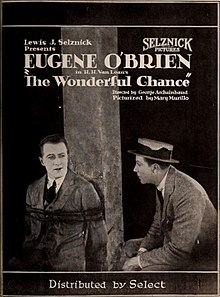| The Wonderful Chance | |
|---|---|
 1922 Advertisement 1922 Advertisement | |
| Directed by | George Archainbaud |
| Written by | H. H. Van Loan (original story) Mary Murillo (scenario) Melville Hammett (scenario) |
| Starring | Eugene O'Brien Martha Mansfield Rudolph Valentino |
| Cinematography | Henry Cronjager |
| Production company | Selznick Pictures |
| Distributed by | Select Pictures |
| Release date |
|
| Running time | 52 minutes; 5 reels (5,137 feet) |
| Country | United States |
| Language | Silent (English intertitles) |
The Wonderful Chance (also The Thug and His Wonderful Chance) is a 1920 American silent crime drama film produced by Lewis Selznick and released by Select Pictures. This picture stars Eugene O'Brien in a dual role and was directed by George Archainbaud. While this film survives today in several archives, it is best known for featuring Rudolph Valentino in a villain role rather than the hero. In the 1960s scenes from the film were used in the documentary The Legend of Rudolph Valentino (1961) narrated by Graeme Ferguson.
Plot
As described in a film magazine, recently released convict 'Swagger' Barlow (O'Brien) is mistaken for Lord Birmingham (O'Brien) and is feted and dined, while the true nobleman is held by a scheming band of crooks. He falls in love with Peggy (Mansfield), the daughter of his host Parker Winton (Cook). Through the actions of Barlow, Lord Birmingham is released. Peggy, after explanations, agrees to wait for Barlow to "come back."
Cast
- Eugene O'Brien as Lord Birmingham / 'Swagger' Barlow
- Martha Mansfield as Peggy Winton
- Tom Blake as 'Red' Dugan
- Rudolph Valentino as Joe Klinsby
- Joseph Flanagan as Haggerty (credited as Joe Flanagan)
- Warren Cook as Parker Winton
Production
Henry Cronjager's use of the "double exposure" method to film an actor on screen in two different roles at the same time, was one of the first uses of this method. This occurs when Eugene O'Brien, in the guise of "Swagger" Barlow, interrogates himself in the persona of Lord Birmingham. Unlike the more common, and easier, method of using a split screen, the use of double exposure allows the actor to appear on the same side of the screen in both roles, in this case allowing Barlow to circle Birmingham.
Preservation
Copies of the film are in the George Eastman House Motion Picture Collection and Museum of Modern Art film archive, and it has been released on DVD.
References
- ^ "Explaining the Mystery of the Movie Double". The Evening Review (East Liverpool, Ohio). January 25, 1921. p. 9. Retrieved September 10, 2017 – via Newspapers.com.

- The American Film Institute Catalog Feature Films: 1911-20 published by The American Film Institute, c.1988
- The AFI Catalog of Feature Films: The Wonderful Chance
- ^ Progressive Silent Film List: The Wonderful Chance at silentera.com
- "Reviews: The Wonderful Chance". Exhibitors Herald. 11 (17). New York City: Exhibitors Herald Company: 86. October 23, 1920.
External links
- The Wonderful Chance at IMDb
- The Wonderful Chance is available for free download at Internet Archive
This article about a silent crime drama film is a stub. You can help Misplaced Pages by expanding it. |
- 1920 films
- American silent feature films
- Films directed by George Archainbaud
- Films based on short fiction
- American crime drama films
- American black-and-white films
- 1920 crime drama films
- Selznick Pictures films
- 1920s American films
- Silent American drama films
- Surviving American silent films
- Silent crime drama film stubs